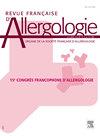Real-world experience with long-term peanut vs. tree nut oral immunotherapy in children: A 5 year single center study from Luxembourg
IF 0.3
4区 医学
引用次数: 0
Abstract
Prérequis/Contexte
Oral immunotherapy (OIT) as a treatment modality for peanut (PN)-allergy is well described in randomised clinical trials, and supported by real-world data. Tree nut (TN)-OIT has also proven safe for pre-school children. However, whether such beneficial OIT outcome can be expected in older children, who often have increased PN/TN-specific IgE and a greater risk for adverse reactions, remains uncertain.
Objectifs
We aim to report our real-world experience with peanut vs. tree nut OIT in older nut-allergic children (up to 18 years) over a 5-year follow up period.
Méthodes
Seventy-one nut-allergic children confirmed by oral food challenge (OFC) were recruited in the study, with 5 patients undergoing consecutive double OIT. Participants (median age 8 years) were followed up for upto 5 years. Multiple OFCs upto a cumulative dose of 3 g nut protein were done to assess for desensitization i.e. at 18, 36 and 60 months. Consortium for Food Allergy Research (CoFAR) Grading Scale version 3.0. was used to classify reactions during OFC and OIT.
Résultats/Discussions
In total, 47 PN-OIT (61.8%) and 29 TN-OIT (38.2%) were performed. Thirty-nine PN-OIT (83%) and 27 TN-OIT (93.1%) reached target maintenance dose (MD) after a mean duration of 14 months. Desensitization (DS) rates was consistently higher for the TN-OIT groups at all follow-up time points. After 6 months of daily MD, a significantly higher proportion of TN-OIT (24/24; 100%) successfully passed OFC compared to PN-OIT (28/38; 73.7%), P = 0.009. With continued OIT, DS rates at 3 and 5 years improved for PN-OIT (78.6% and 77.8%). The overall risks of allergic reactions during the build-up phase was equivalent in both groups (Incidence risk ratio; IRR 0.9, 95% CI 0.7-1.1). However, during the maintenance phase, PN-OIT participants had a higher risk of reactions (IRR 0.3, 95% CI 0.2-0.5) and a higher risk of severe reactions compared to TN-OIT (CoFAR Grade 3: IRR 0.2; 95% CI 0.1-0.4). Overall TN-OIT was associated with a more favorable long-term OIT outcome.
Conclusion
Using the same inclusion criteria and immunotherapy protocol, we observe that real-world long-term TN-OIT in older children resulted in more favorable outcome than PN-OIT.
儿童长期花生与树坚果口服免疫治疗的实际经验:来自卢森堡的一项为期5年的单中心研究
口服免疫疗法(OIT)作为花生(PN)过敏的一种治疗方式在随机临床试验中得到了很好的描述,并得到了现实世界数据的支持。树坚果(TN)-OIT也被证明对学龄前儿童是安全的。然而,这种有益的OIT结果是否可以在年龄较大的儿童中预期,他们通常有增加的PN/ tn特异性IgE和更大的不良反应风险,仍然不确定。目的:我们的目标是报告我们在5年随访期间对花生和树坚果油过敏的年龄较大的儿童(18岁以下)的真实经验。研究招募了71名经口服食物刺激(OFC)证实的坚果过敏儿童,其中5名患者连续接受双OIT治疗。参与者(中位年龄8岁)的随访时间长达5年。在18个月、36个月和60个月时,进行了多次ofc,累计剂量为3g坚果蛋白,以评估脱敏情况。食物过敏研究联盟(CoFAR)分级量表3.0版。用于对OFC和OIT期间的反应进行分类。共行PN-OIT 47例(61.8%),TN-OIT 29例(38.2%)。平均14个月后,39例PN-OIT(83%)和27例TN-OIT(93.1%)达到目标维持剂量(MD)。在所有随访时间点,TN-OIT组的脱敏率始终较高。每日MD治疗6个月后,n - oit比例显著升高(24/24;与PN-OIT (28/38;73.7%), p = 0.009。如果继续进行OIT, PN-OIT患者3年和5年的DS率分别提高了78.6%和77.8%。两组在积累阶段过敏反应的总体风险相等(发病率风险比;Irr 0.9, 95% ci 0.7-1.1)。然而,在维持期,与TN-OIT相比,PN-OIT参与者有更高的反应风险(IRR 0.3, 95% CI 0.2-0.5)和更高的严重反应风险(CoFAR 3级:IRR 0.2;95% ci 0.1-0.4)。总体而言,TN-OIT与更有利的长期OIT结果相关。结论使用相同的纳入标准和免疫治疗方案,我们观察到现实世界中长期TN-OIT比PN-OIT效果更好。
本文章由计算机程序翻译,如有差异,请以英文原文为准。
求助全文
约1分钟内获得全文
求助全文
来源期刊

Revue Francaise d Allergologie
Medicine-Immunology and Allergy
自引率
33.30%
发文量
349
期刊介绍:
La Revue Française d''Allergologie : un véritable forum pour faire connaître des travaux originaux et permettre la diffusion de l''information auprès de toutes les spécialités concernées par les pathologies allergiques. La Revue Française d''Allergologie (8 numéros par an) est au carrefour de nombreuses spécialités - dermatologie, pédiatrie, ORL, pneumologie, ophtalmologie, médecine interne - qui, toutes, ont à traiter des maladies allergiques. Les symptômes des allergies fondés sur des mécanismes communs sont le plus souvent associés et se succèdent chez un même patient. En forte progression depuis 20 ans, les maladies allergiques sont dans l''attente de perfectionnements et d''avancées thérapeutiques qui permettront aux nombreux patients qui en sont atteints de mieux vivre avec leurs allergies. La Revue Française d''Allergologie se veut donc un véritable forum de discussions et d''échanges entre tous les spécialistes confrontés aux pathologies
 求助内容:
求助内容: 应助结果提醒方式:
应助结果提醒方式:


